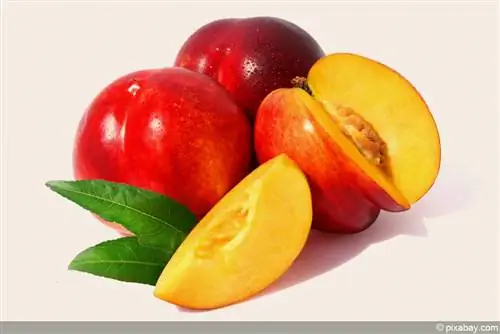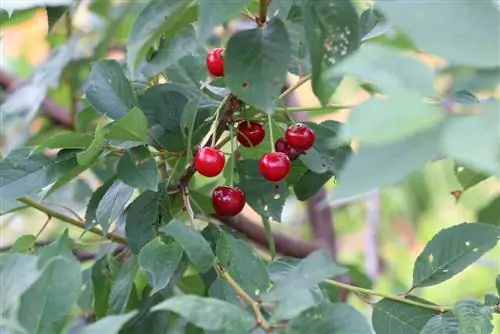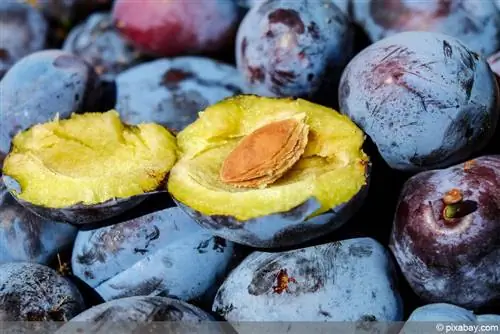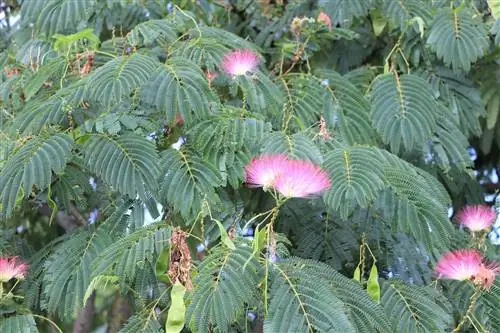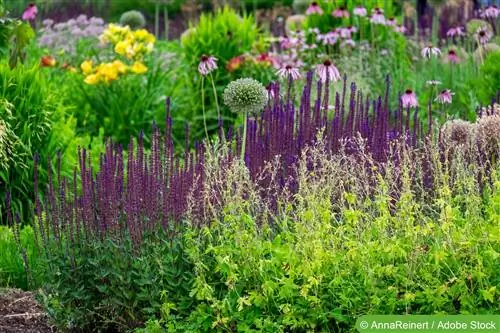- Author admin [email protected].
- Public 2023-12-17 03:39.
- Last modified 2025-06-01 06:48.
The juicy nectarines are related to peaches, but they differ particularly in their surface. In contrast to their relatives, nectarines have smooth skin, but taste at least as good. However, their taste is even better when they are picked fresh (from a home-grown tree). Read how to grow the exotic plant here!
The Location
Nectarines in Europe are mainly grown in Greece, France and Italy and therefore prefer a warm climate. In local regions, the trees thrive best in wine-growing areas, but with a little skill they can be grown anywhere - as long as the optimal conditions are created. Since the nectarine trees are not particularly resilient, they have corresponding requirements, especially in terms of location:
- sunny and warm place
- outdoors preferably on the south side of the property
- A south-facing house wall is also suitable
- protected from rain and wind
The substrate
The plants can be cultivated both outdoors and in pots. The soil should be as low in lime as possible, because a high proportion of lime in the soil can lead to chlorosis, whereupon the leaves of the nectarine tree turn yellow. Likewise, if possible, they should not be planted in heavy, cold soil. The nectarine trees need warmth, which is why they prefer a substrate that can be easily heated. The optimal soil for the peach relatives has the following characteristics:
- nutrient-rich
- humus-rich
- calcareous
- Slightly acidic potting soil is recommended for the pot
Tip:
Heavy soil in the garden can easily be prepared for growing nectarines. To do this, the soil is simply enriched and loosened with a mixture of sand and humus.
The Cultivation
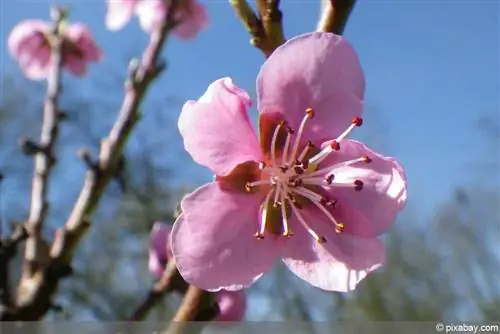
Nectarine trees are available in stores both as container trees and as bare-root trees. Anyone who decides to grow the exotic tree also has to choose whether to grow it in a pot on the balcony or in their own garden. Depending on the form in which the plant is purchased and grown, planting is different.
The bare root nectarine tree
A bare-root tree is called that because it is offered without the ball of earth around the roots and these are therefore “naked”. Although these are comparatively cheap to purchase, the planting time is limited to spring and autumn. It is also important to act quickly with bare-root plants and plant them immediately after purchase. First, the root system is freed from all kinks and breaks by cutting them out directly at the roots. The roots are then shortened to around 30 centimeters and the shoots by around a third. The plant is then placed in the water for around an hour before it is planted as follows:
- digging a planting hole
- this must be deeper than the roots are long (optimally 1.5 times deeper)
- Planting a tree vertically
- Shovel soil into the planting hole
- the root collar should be at the same height as the surface of the earth
- Tread the earth carefully
- Create a watering edge and water abundantly
- Ideally, a thick layer of mulch is placed on the planting site
The nectarine tree in the container
The biggest advantage of container plants is the ability to plant them all year round. In addition, unlike bare-root plants, these do not need to be cut back after planting. However, anyone who decides to purchase a nectarine tree in a container must also make special preparations before planting. To do this, three crosses are first scratched into the root balls, each of which should be around 0.5 centimeters deep. This encourages the nectarine tree to form and spread its roots more quickly. The root balls are then dipped in water and left until no air bubbles are visible. The plants can then be planted in the garden as follows:
- Dig up planting hole
- this should be twice the size of the root ball
- Fill the planting hole around 30 percent with garden compost
- place the tree as straight as possible
- If necessary, insert a support post
- fill the planting hole with a mixture of soil and compost
- However, the root ball should be covered with soil by a maximum of 1 cm
- Tread the earth carefully
- Form a pouring edge that slopes towards the middle
- finally connect the tree trunk and the support post with a ribbon
- and add a thick layer of mulch to the planting site
The culture in the bucket
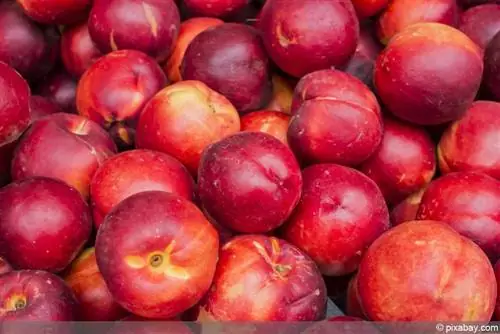
The nectarine trees can be easily cultivated in pots, but this form of cultivation is only recommended for the dwarf varieties. The “normal” nectarine trees can reach an impressive height of up to eight meters. Dwarf nectarines, on the other hand, usually reach a height of around one meter and are therefore more suitable for growing on the balcony. The right containers, which should have a capacity of around 30 to 40 liters, are essential for culture in the bucket. They should also be equipped with a drainage hole, because the nectarines absolutely cannot tolerate waterlogging. If the nectarine trees are cultivated in a container, it is best to proceed as follows:
- first place a drainage over the drainage hole
- Gravel, perlite and pottery shards are suitable for this
- then cover the drainage with a permeable garden fleece
- and cover with substrate
- A mixture of garden soil, compost and horn shavings is ideal
- insert the tree in the middle
- fill the bucket with soil
- up to a few centimeters below the edge of the bucket
- If necessary, insert a support post
- water abundantly
Tip:
In order to avoid waterlogging, coasters should be avoided if possible.
Care
The care required for nectarine trees is comparatively low because they are relatively undemanding. In the open field, the plants are often visited and nibbled by hares and rabbits, which is why the trees should be checked regularly for signs of feeding. However, the damage caused by corrosion is not a problem because it can be easily smoothed out with a knife. The actual care required is the same for both the nectarines outdoors and the plants grown in pots and is as follows:
Fertilizing and watering
The easy-care plants are fertilized with a complete fertilizer about two to three times a year, although spring and summer are best suited for this. Young nectarine trees in particular are watered because they should be watered regularly, especially in the first year after planting. From the second year onwards, however, it is sufficient if the trees are only watered when it is dry. Since the plants cannot tolerate lime, they should preferably be supplied with stale rainwater. It is also recommended to mulch the nectarine trees. This not only keeps the root area warm, but also moist.
Cutting
In the first two years after planting, the nectarine trees are generally not cut so that they can grow unhindered. The first cut usually takes place in the third year and should then be done once a year. This primarily serves to maintain the vitality of the tree, while at the same time it can be brought into the desired shape with the cut. Ideally, nectarine trees should be pruned shortly before flowering in April or early May, but alternatively they can also be pruned in late summer. The best way to cut nectarine trees is as follows:
- first remove old and dead wood
- cut branches growing inwards
- Cutting water shoots
- these are branches that grow steeply upwards
- As a rule, about a third of the shoots are cut off
- never cut below the bud
Tip:
In order to make the cut as gentle as possible on the tree, it is recommended to cut the shoots at an angle. This means that the cuts not only heal faster, but also better. In addition, the branches should always be cut off and not crushed with the cutting tool.
The different shoots
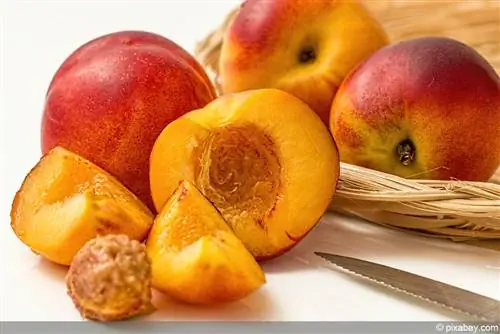
The nectarine tree forms its fruit on last year's shoots and should therefore not be cut. For this it is essential that the hobby gardener can distinguish the fruit-bearing shoots from the others. First there are the wooden shoots, which only have pointed leaf buds. There are also “false” fruit shoots that can be recognized by their single, rounded flower buds. The false fruit shoots do produce fruit, but the tree drops them early because it cannot supply them with enough food. However, the most important shoots are the “true” fruit shoots, as these - again the name suggests - bear the tasty fruits. These are relatively easy to recognize because, unlike the false fruit shoots, they not only have one flower bud, but so-called “bud triplets”. Because next to the rounded flower bud there is a leaf bud on the left and right. Distinguishing between the different shoots is important for cutting because they are processed differently:
- remove false fruit shoots
- these are cut on astring or cones
- shorten true fruit shoots
- because there are only simple flower buds at the end of the shoot
- cut well-developed, true fruiting shoots back to 8 bud triplets
- cut back weakly developed shoots to 3 to 4 bud triplets
Wintering
The warmth-loving nectarines can be overwintered without any problems as long as they are protected accordingly. For outdoor plants, it is recommended to cover the roots with brushwood, leaves and straw. Young trees in particular need additional protection, which is why it is advisable to wrap their trunks with fleece or jute. A cool, bright winter quarter is optimal for nectarine trees grown in containers. However, they should not be brought indoors as the heat could harm them in winter. It is better to overwinter them in a winter garden, a garden shed or a garage. As far as care is concerned, the nectarine trees are extremely undemanding in winter:
- Water potted plants occasionally
- dry soil is better than soil that is too wet
- protect from drafts
- If the location is too dark, provide artificial lighting
Harvesting and propagation
The sweet nectarines are usually harvested from August to September. You can tell whether the fruit is ripe with a gentle press of your finger: ripe fruit is easy to press. Nectarines taste best when they are freshly harvested. But that's not the only reason why they should be consumed as quickly as possible, because their shelf life in the refrigerator is only a few days. However, new nectarine trees can be grown from the seeds of the fruit. However, patience is required for this, because the kernels must first be dried for a few weeks (or months!). To grow new plants from the seeds, proceed as follows:
- fill a 15 cm pot with potting soil
- this shouldn't be too wet
- Put the core in and add a thin layer of soil over it
- from now on keep the soil moist at all times
- but avoid waterlogging
- cover the pot with foil
- but remove these regularly
- the optimal germination temperature is 24 degrees
- after a few weeks the germ forms
- As soon as the seedling is 20 cm high it is planted out
Tip:
Alternatively, the cores can also be placed in cotton wool instead of soil.
Conclusion
The nectarine trees can be easily cultivated outdoors or in containers in this region. They are ideal for beginners as the plants are considered relatively undemanding. The maintenance required is comparatively low, but they definitely need a bright, warm location and an annual cut in order to be able to grow and thrive properly.

